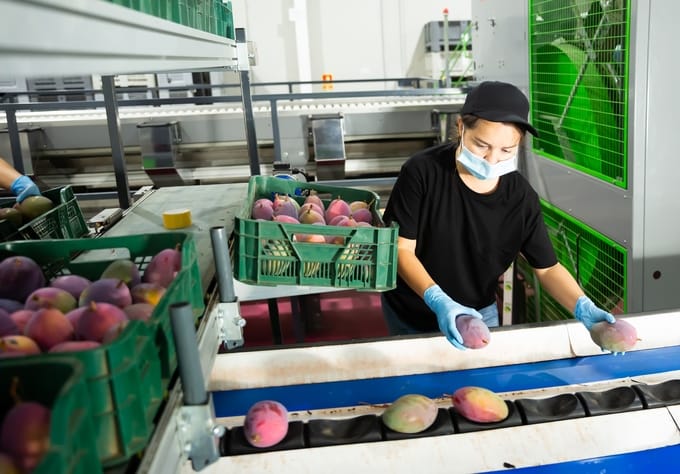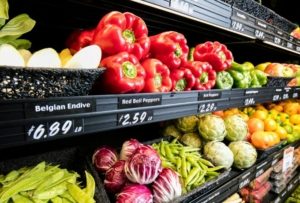Are You Prepared for FSMA Rule 204? Here’s What You Need to Know
By iFoodDS Team
June 6, 2022
Note: This content has been updated to reflect the final version of FSMA Rule 204.
The FDA finalized FSMA Rule 204 on November 15, 2022. What are you doing to prepare for compliance with the new requirements? Have you thought about how you can leverage traceability as a competitive advantage and brand differentiator?
Companies who focus merely on compliance and on their single link in the supply chain are missing out on the opportunity to shape the future of food safety. Furthermore, they are exposing their company to potential risks such as reduced consumer trust and limited visibility into their supply chain that could hinder product quality and safety. Read on to learn about the background of Rule 204 and why you should start thinking beyond compliance.
What Is FSMA Rule 204?
In 2011, the Food Safety Modernization Act (FSMA) was signed into law. Section 204 of FSMA, the Food Traceability Final Rule, establishes additional recordkeeping requirements for entities that manufacture, process, pack, or hold foods on the Food Traceability List.
What Is the Food Traceability List?
The Food Traceability List (FTL) is a list of the foods that will be subject to additional recordkeeping requirements under FSMA Rule 204. The FDA started working on a draft list in 2014 and published the final list on November 15, 2022, with no changes other than adding clarification on certain categories. The FTL includes:
- Many fresh fruits and vegetables:
- Fresh cucumbers, herbs, leafy greens, melons, peppers, sprouts, tomatoes, tropical tree fruits, all fresh-cut fruits, and all fresh-cut vegetables
- A variety of soft cheeses:
- Fresh soft, soft unripened, soft ripened, and semi-soft cheeses made from pasteurized milk
- Cheeses made from unpasteurized milk, other than hard cheeses
- Shell eggs
- Nut butters
- Some categories of seafood:
- Fresh and frozen finfish, refrigerated and frozen smoked finfish, fresh and frozen crustaceans, and fresh and frozen molluscan shellfish and bivalves
- Refrigerated RTE (ready-to-eat) deli salads
What Are the FDA Food Traceability Requirements?
If you harvest, cool, pack, ship, process, manufacture, or receive any of the foods on the Food Traceability List, you are required to keep additional records on these items. The FDA has defined a set of metrics called Key Data Elements (KDEs) that correspond to different events in the supply chain called Critical Tracking Events (CTEs). The CTEs are:
- Harvesting
- Cooling
- Initial Packing (applies to Raw Agricultural Commodities not obtained from a fishing vessel)
- First Land-Based Receiver (applies only to seafood)
- Shipping
- Receiving
- Transformation
To determine what KDEs you would need to record, consult the FDA’s resource guide on Critical Tracking Events and Key Data Elements. Depending on the details of your business operation, you may need to capture multiple sets of KDEs. For example, a processor could be considered a receiver, a transformer, and a shipper since they take physical possession of product from a supplier and they also commingle, repack, relabel, or otherwise transform the product, then ship the product to their customers.
In addition to capturing these KDEs, the FDA has outlined these requirements:
- Create and maintain a traceability plan (see details below).
- Maintain records as original paper records, electronic records, or true copies (must be legible and stored to prevent deterioration or loss).
- Provide traceability records (and any information necessary to understand these records) to the FDA no later than 24 hours after a request is made (or within a reasonable time to which the FDA has agreed).
- *Provide an electronic sortable spreadsheet containing relevant traceability information to the FDA within 24 hours of a request (or within some reasonable time to which the FDA has agreed) when necessary to assist during an outbreak, recall, or other public health threat.
Creating a Traceability Plan
A new requirement in the final rule is the traceability plan. This plan covers:
- The procedures you use to maintain your traceability records (including format and location of records)
- Procedures you use to identify foods on the FTL that you manufacture, process, pack, or hold
- How you assign traceability lot codes
- Point of contact for questions on your traceability plan and records
Additionally, those who grow or raise food on the FTL (other than eggs) must include a farm map showing the areas where they grow/raise those foods. The farm map needs to show the location and name of each field/growing area, geographic coordinates, and any other information needed to identify the location.
When Does FSMA 204 Go Into Effect?
The Food Traceability Rule (FSMA 204) went into effect January 2023, 60 days after the final rule publication in November 2022. The FDA will give companies a period of three years to comply, so you will have until January 20, 2026, to become fully compliant. However, it is imperative for companies to start preparing now since vetting and implementing a food traceability solution takes time and careful consideration. If you wait until just before the 2026 compliance date to start preparing, you may find it difficult to meet the deadline.
What Can I Do to Prepare for FSMA Rule 204?
Here are 6 steps you can take now to prepare for enforcement of FSMA Rule 204:
- Identify any of your products that are on the Food Traceability List.
- Familiarize yourself with the Critical Tracking Events and understand what Key Data Elements you’re required to capture and store based on your role in the supply chain.
- Ensure these Key Data Elements are captured and stored in a way that’s easily accessible.
- Talk to your supply chain partners about what they are doing to prepare for Rule 204 compliance.
- Harmonize your labels across all suppliers and consider using labels that align with PTI standards to make it easier to get the information you need from suppliers.
- Start vetting traceability solutions now, keeping in mind what features you will need and which solutions offer that.
Although the FDA permits paper records, many companies will turn to technology to help them meet FSMA Rule 204 requirements. If you’re considering a digital traceability solution, look for a platform that automates KDE collection and stores the data securely so you can access it as needed. Another important feature is the ability to traceback and traceforward. You’ll want the ability to trace a product instantly in case of an investigation or recall.
Why Compliance Isn’t Enough
FSMA 204 appears to be a concerted effort to get the industry on the same page when it comes to traceability. However, companies who focus merely on their own link in the supply chain will be left behind in the coming years as the top companies in the industry embrace full supply chain visibility.
The industry needs to work together to solve major food safety issues. Foodborne illness outbreaks harm public health, erode trust, and cost companies billions of dollars. With the finalization of FSMA 204, we have a chance to make meaningful progress on these deeply entrenched issues. Going beyond compliance is the best way for companies across the supply chain to pursue this. We envision a future where companies align together to provide end-to-end supply chain traceability.
The True Intent of FSMA 204
iFoodDS believes the ultimate intent of FSMA 204 is to create a fully transparent supply chain that ensures safer food for all. This kind of transparency comes from having real-time food safety data available on-demand.
Companies can’t afford to focus on their single link in the chain or delay in preparing for the enforcement date of January 2026. The stakes are simply too high.
Lack of visibility could put you at risk
Doing the bare minimum to comply with FSMA 204 could leave you vulnerable. Imagine if you keep paper records and then need to provide the FDA with an electronic sortable spreadsheet in 24 hours. Would your team be able to achieve this on such a tight deadline?
Now imagine a scenario where you only keep the records for your link in the supply chain but need to trace product back to the lot level. Do you want to find out your suppliers aren’t in compliance when it matters most – during an outbreak investigation? By ensuring full traceability across your suppliers, you’ll gain visibility into the entire supply chain. This not only shields you from many food safety risks but also helps you make better sourcing decisions, improving your supplier mix. Protect your brand and limit your recall exposure by embracing end-to-end traceability.
The Food Traceability List will likely grow
It makes sense to adopt detailed record keeping across all your products so you’re already prepared if more commodities are added to the Food Traceability List in the future. This also makes your processes more efficient and ensures consistency across all products.
You’ll gain a competitive advantage by embracing traceability
Consumers are demanding more transparency in the food they purchase. They want to know their food is safe, high-quality, and sustainable. One survey found that 71% of consumers feel traceability is important and would even pay a premium for traceable products.
In response to growing consumer demands, buyers are raising the bar on their standards to protect their brand reputation. You can gain buyer preference over your competitors by going beyond compliance and enabling full supply chain transparency.
Is a Network Traceability Approach the Key?
The biggest obstacle to improving outbreak response has been the complexity of the supply chain. Even though the technology for full supply chain traceability exists, it’s virtually impossible to get every participant in the supply chain to agree on a single vendor. Interoperability is a necessary feature for any traceability solution.
A network approach may be the most efficient and effective way to bring the whole industry into compliance. In a network approach, the biggest players in the industry vet traceability solutions for their own supply chain partners and use their resources to assist with implementation. Smaller companies receive support, resources, and guidance as they navigate FSMA 204 requirements. Large retailers, processors, manufacturers, distributors, and foodservice operators get an effective traceability solution to ensure compliance across their supplier network.
iFoodDS has developed a Network Traceability solution that benefits you as well as your network of suppliers. If you’re exploring options for traceability technology and would like to learn more, reach out to iFoodDS for a no-cost traceability consultation. For additional guidance in creating your path to compliance, we recommend reaching out to our consulting partners at New Era Partners.
*Some exemptions apply. See § 1.1305 of the final rule for a list of exemptions.
This material is for informational purposes only and not for the purpose of providing legal advice. You should contact your attorney to obtain advice with respect to any particular issue or problem.







